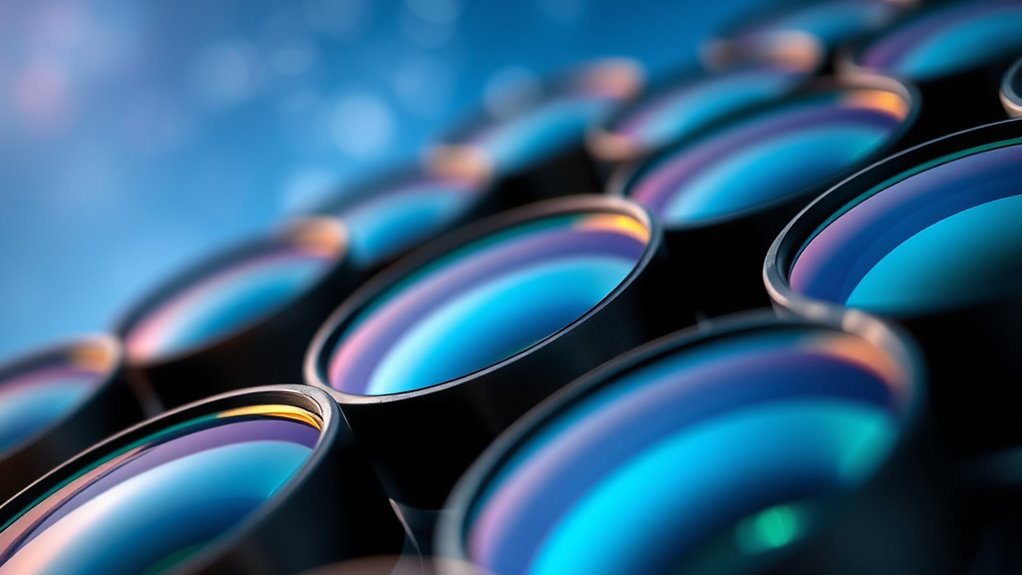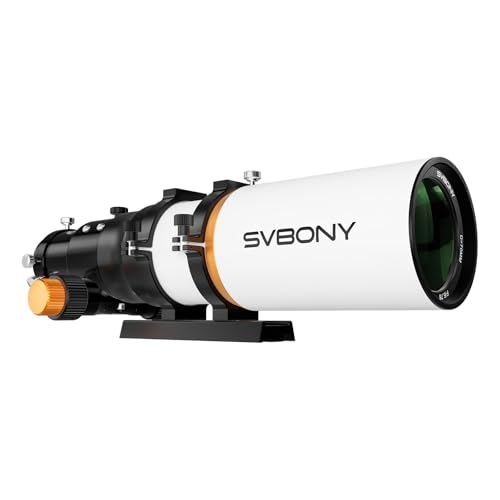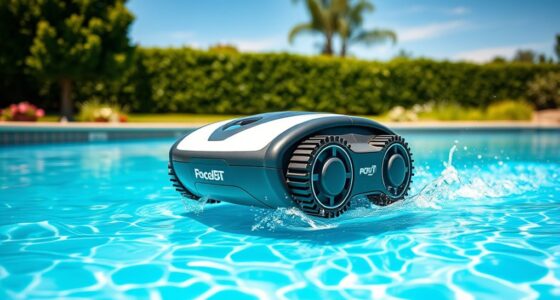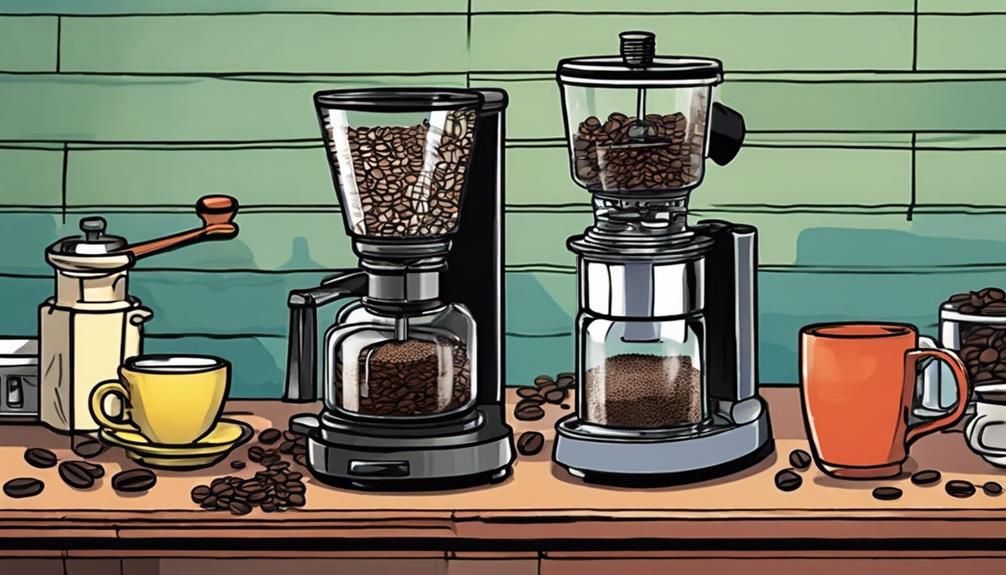I’ve found that using a field flattener can substantially enhance my stargazing experience with refractor telescopes. These accessories guarantee sharp, distortion-free images across the entire field of view. I particularly like the SVBONY SV503 with its built-in flattener, as well as the Astromania 2 Field Flattener for great astrophotography results. You’ll want to take into account factors like optical compatibility and durability for the best results. Keep exploring to discover more options and tips!
Key Takeaways
- Field flatteners improve image quality by correcting field curvature and minimizing optical aberrations like coma and astigmatism for clearer celestial images.
- Choosing a flattener compatible with your telescope’s focal ratio and aperture prevents vignetting and enhances overall performance in astrophotography.
- Effective focal length reduction provides a wider field of view, ideal for capturing large celestial objects while improving light-gathering efficiency.
- Durable construction with high-quality materials ensures longevity and stability, minimizing flexure and vibrations during use with heavy camera setups.
- Easy setup and portability are vital, with lightweight models simplifying transport and installation, while mid-range options balance cost and optical quality.
SVBONY SV503 Refractor Telescope with Built-in Field Flattener
If you’re an amateur astronomer looking to capture stunning, distortion-free images of celestial objects, the SVBONY SV503 Refractor Telescope with its built-in field flattener is an excellent choice. This telescope’s 70mm aperture and F/6.78 focal ratio deliver bright, sharp images, enhancing your stargazing experience. Thanks to the advanced ED glass, chromatic aberration is minimized, ensuring true-to-life color reproduction. The flat-field correction allows for wide views without edge blurring, perfect for exploring galaxies and nebulae. Plus, pairing it with the SV305C Pro Camera considerably boosts your ability to capture detailed planetary images, even in low-light conditions.
Best For: Amateur astronomers seeking a user-friendly telescope that delivers high-quality, distortion-free images of celestial objects.
Pros:
- High-quality optics: The built-in field flattener and ED glass minimize chromatic aberration for true-to-life color reproduction.
- User-friendly design: The telescope’s lightweight and ergonomic structure makes it easy to set up and use for extended periods.
- Enhanced imaging capabilities: When paired with the SV305C Pro Camera, it allows for detailed planetary photography even in low-light conditions.
Cons:
- Limited aperture size: The 70mm aperture may not gather as much light as larger telescopes, potentially limiting deep-sky observations.
- Fixed focal ratio: The F/6.78 focal ratio may not be as versatile for all types of astrophotography as some users might prefer.
- Beginner-friendly features: While great for amateurs, experienced astronomers may find the features less advanced compared to high-end telescopes.
SVBONY SV503 Refractor Telescope for Astrophotography and Visual Astronomy
The SVBONY SV503 Refractor Telescope stands out as an exceptional choice for both astrophotography enthusiasts and visual astronomers due to its built-in field flattener, which delivers remarkably sharp, distortion-free images. With a 70mm aperture at F/6.78, I’ve captured stunning visuals of galaxies and nebulae, all while minimizing chromatic aberration. The dual-speed focuser allows precise adjustments, making it easy to focus on fine details. Plus, it’s lightweight and portable, perfect for travel. Users rave about its optical clarity and build quality, making it an affordable alternative to pricier scopes. I highly recommend it for anyone looking to enhance their stargazing experience!
Best For: The SVBONY SV503 Refractor Telescope is best for both beginners and experienced astronomers who seek a high-quality, affordable option for astrophotography and visual observation.
Pros:
- Outstanding optical performance with minimal chromatic aberration and sharp, distortion-free images.
- Lightweight and portable design makes it easy to travel and set up quickly for stargazing.
- High-quality build with durable materials and a reliable dual-speed focuser for precise adjustments.
Cons:
- Limited aperture size may not capture as much light as larger telescopes, affecting performance in very dim conditions.
- Accessories may be needed for optimal astrophotography, such as focal reducers, which are not included.
- Learning curve for beginners in mastering astrophotography techniques and equipment setup.
SVBONY SV193 Focal Reducer and Field Flattener with SV305C Pro Telescope Camera
Astrophotography enthusiasts seeking to enhance their imaging experience will find the SVBONY SV193 Focal Reducer and Field Flattener an excellent choice. Designed for refractor telescopes, this 2-inch 0.8x reducer not only shortens focal length but also eliminates edge distortion, resulting in stunning celestial photographs. When paired with the SV305C Pro camera, I can capture high-quality planetary details even in challenging light conditions, thanks to its ultra-high sensitivity and low noise. The compatibility with full-frame sensors makes it a versatile tool for anyone serious about astrophotography, ensuring bright and flat images across the entire frame.
Best For: Astrophotography enthusiasts and amateur astronomers looking to improve their imaging capabilities with high-quality equipment.
Pros:
- Reduces focal length, allowing for wider field imaging and capturing more of the night sky.
- Eliminates edge distortion, ensuring sharp and clear images across the entire frame.
- Compatible with full-frame sensors, making it versatile for a range of astrophotography setups.
Cons:
- May require additional adapters for certain telescope models, potentially increasing setup complexity.
- Not suitable for all types of telescopes, limiting its usability to refractor telescopes.
- Price may be higher compared to basic focal reducers, which could deter budget-conscious buyers.
Astromania 2 Field Flattener for Astronomy Photos
For anyone serious about astrophotography, the Astromania 2 Field Flattener stands out as an essential tool that guarantees perfect image flatness. Compatible with refractor telescopes ranging from f/4 to f/8, it ensures complete aperture illumination. I appreciate the 109mm back focus, which allows for easy accessory attachment. The high-quality multi-coated lenses enhance light transmission, resulting in sharp stars across the entire image field. While some users report setup challenges, I found that once properly adjusted, it delivered stunning results. With positive feedback on image quality, this flattener has truly improved my astrophotography experience, making it a worthwhile investment.
Best For: Astrophotographers looking to enhance image quality and achieve flat field correction with refractor telescopes from f/4 to f/8.
Pros:
- High-quality multi-coated lenses improve light transmission and image clarity.
- Provides consistent flat-field correction, resulting in sharp stars across the entire image field.
- 109mm back focus accommodates additional accessories easily.
Cons:
- Some users report difficulty in setup despite following instructions.
- Mixed customer feedback regarding the ease of use and support.
- Star elongation issues may still occur if not properly adjusted.
SVBONY SV503 Portable Telescope Tube for Astrophotography and Visual Astronomy
Looking to enhance your astrophotography experience? The SVBONY SV503 Portable Telescope Tube is a game changer. With its high-quality S-FPL51 ED glass, it virtually eliminates chromatic aberration, providing sharp, high-contrast images. I love how compact and portable it is, making it easy to transport. The micro-reduction focuser is smooth and precise, perfect for quick adjustments. Plus, the 0.8x reducer allows for stunning wide-field captures. Users rave about its value and performance, often comparing it to pricier options. Overall, the SV503 balances durability and optical excellence, making it ideal for both beginners and seasoned astronomers.
Best For: The SVBONY SV503 Portable Telescope is best for both aspiring astrophotographers and experienced astronomers seeking a high-quality, budget-friendly option for visual astronomy and imaging.
Pros:
- High-quality S-FPL51 ED glass virtually eliminates chromatic aberration for sharp images.
- Compact and portable design makes it easy to transport for outdoor observations.
- Smooth, precise micro-reduction focuser allows for quick and accurate adjustments.
Cons:
- Some users may experience minor corner star distortion during astrophotography that requires post-processing.
- Upgrades like field flatteners may be necessary for perfect star shapes across the frame.
- Limited to a specific focal length, which may not suit all observational preferences.
Factors to Consider When Choosing Field Flatteners for Refractor Telescopes

When I’m choosing a field flattener for my refractor telescope, I always consider several key factors. Optical compatibility and design are vital, as they directly impact image quality. Additionally, I look at how the flattener will affect focal length and the overall ease of setup.
Optical Compatibility and Design
Selecting the appropriate field flattener for your refractor telescope is essential, as it can significantly influence image quality. First, verify the flattener matches your telescope’s focal ratio and aperture to prevent vignetting and image degradation. If you’re into wide-field astrophotography, confirm that the optical design supports full-frame cameras. It’s also critical that the flattener’s optical elements are optimized to minimize chromatic aberration while maximizing image sharpness across the entire field. Don’t forget to confirm that the back focus distance aligns with your telescope’s specifications for proper focus. Finally, consider whether the flattener works well with your specific optical setup, like doublet or triplet refractors, to guarantee top performance. This attention to detail will enhance your stargazing experience.
Focal Length Reduction Effects
How can focal length reduction enhance your astrophotography experience? By decreasing the effective focal length, a field flattener gives you a wider field of view, perfect for capturing expansive celestial objects. I love using a focal reducer because it boosts light-gathering efficiency, resulting in brighter images and shorter exposure times. This reduction in focal length lowers magnification, which is great for imaging large nebulae and galaxies, but it can limit the details in planetary views. It’s crucial to adjust your camera settings or pixel scale for achieved results since the changes in focal length affect the image scale on your sensor. Choosing the right focal reducer minimizes optical distortion, ensuring sharp stars across that expanded field.
Image Quality Enhancement
After experiencing the benefits of focal length reduction with my astrophotography, I’ve come to appreciate the significant role field flatteners play in enhancing image quality. They correct field curvature, ensuring sharp stars across the entire image frame. This means that the celestial objects remain in focus from the center to the edges, which is vital for capturing stunning details. A well-designed flattener minimizes optical aberrations like coma and astigmatism, resulting in clearer images. By using one, I’ve noticed there’s less need for post-processing to fix star elongation caused by optical imperfections. Ultimately, the quality of image flatness provided by a flattener greatly impacts the accuracy and detail in my astrophotography, especially when working with full-frame sensors.
Mechanical Build Quality
When selecting a field flattener for refractor telescopes, the mechanical build quality plays a essential role in ensuring ideal performance. I look for models with durable, precisely machined metal components, like anodized aluminum or stainless steel, to guarantee longevity. It’s indispensable that the construction features tight-fitting threading and secure attachment points to maintain optical alignment and prevent any loosening during use. Mechanical stability is critical, especially when using heavy camera accessories; the flattener should resist flexure or movement. I also appreciate smooth, well-crafted focusing threads that allow for easy installation and precise adjustments. A robust design minimizes vibrations, ensuring consistent positioning—necessary for capturing sharp, distortion-free images during my stargazing sessions.
Ease of Setup
While mechanical build quality is essential for performance, ease of setup is just as important when choosing a field flattener for refractor telescopes. I’ve found that a good flattener should be easy to attach and align, requiring minimal adjustments for initial setup. Clear instructions or markings can make installation and focusing adjustments straightforward. Additionally, compatible thread sizes and simple connection methods save me time and effort when assembling my gear. Some flatteners even feature adjustable elements or spacers that allow fine-tuning without needing complex tools. A user-friendly design means I can set up quickly, making it more enjoyable for both beginners and experienced astronomers like me. A smooth setup can make all the difference in my stargazing experience.
Portability and Weight
Choosing a field flattener for my refractor telescope means considering portability and weight, especially if I plan to take my setup on the go. Lightweight models, typically under 200 grams, are perfect for this, making them easy to carry and attach to portable systems. Heavier options, over 300 grams, can complicate things, requiring sturdier mounts and adding unnecessary bulk. I’ve found that compact flat-field correction devices fit seamlessly into my travel kit, minimizing space while ensuring I have what I need. Portability directly impacts how quickly I can set up and break down my gear in the field. A well-designed, lightweight flattener maintains the balance of my telescope, ensuring stable and comfortable observing sessions wherever I go.
Price and Value Considerations
How do I determine the right balance between price and value when selecting a field flattener for my refractor telescope? I’ve found that prices typically range from $50 to over $200, depending on quality and features. While budget options may work for beginners, they often require adjustments to get decent images. Personally, I’ve learned that investing in a mid-range or premium flattener pays off in the long run. Higher-priced flatteners usually offer superior optical coatings and durability, which enhance image quality and reliability. It’s crucial to take into account compatibility with my setup and my specific astrophotography needs. Ultimately, I weigh the cost against the benefits of improved performance and longevity to ensure I’m making a wise investment.
Frequently Asked Questions
How Do Field Flatteners Improve Image Quality in Refractor Telescopes?
Field flatteners considerably improve image quality in refractor telescopes by correcting the curvature of the field that often distorts images at the edges. When I use a field flattener, I notice the stars become sharper and clearer across the entire field of view. This enhancement allows me to enjoy a more detailed and immersive stargazing experience, making it easier to capture stunning astrophotography and appreciate the beauty of the night sky.
Can Field Flatteners Be Used With All Types of Refractor Telescopes?
Field flatteners can’t be used with all types of refractor telescopes. For instance, I once tried using a flattener on my vintage 80mm refractor, and it just didn’t mesh well. They typically work best with fast refractors that have a shorter focal ratio. If your telescope’s design supports it, a flattener can considerably improve edge-to-edge image quality, but you’ll want to check compatibility before making a purchase.
What Is the Difference Between a Field Flattener and a Focal Reducer?
A field flattener corrects the curvature of the field in a refractor telescope, ensuring sharp stars across the entire image. On the other hand, a focal reducer not only flattens the field but also reduces the focal length, allowing for a wider field of view and faster exposure times. I’ve found that using either can enhance my astrophotography, but they serve different purposes based on what I want to achieve in my observations.
Do I Need a Field Flattener for Visual Astronomy?
You don’t necessarily need a field flattener for visual astronomy, but it can enhance your experience. When I first started, I noticed that my images were sharper and more focused with one. If you’re using a refractor telescope, a flattener can help reduce distortion at the edges, making the stars look crisper. However, if you’re just enjoying the view, you might not miss it right away. It’s about your preferences!
How Do I Properly Attach a Field Flattener to My Telescope?
To properly attach a field flattener to my telescope, I first make sure the telescope is turned off and stable. Then, I remove the diagonal or eyepiece and replace it with the field flattener, making certain it fits snugly. I check for any adapters needed to achieve the correct spacing. Finally, I secure everything tightly and double-check alignment before heading out for a night of stargazing. It’s that simple!
Conclusion
In my journey through the cosmos, I’ve discovered that the right field flattener can transform your stargazing experience, much like a key revealing the mysteries of the universe. Whether you’re capturing the beauty of the night sky or simply enjoying a visual feast, these top picks will elevate your observations. So, gear up, and let these tools guide you on your adventure—after all, the stars are waiting, and they have stories to tell!















